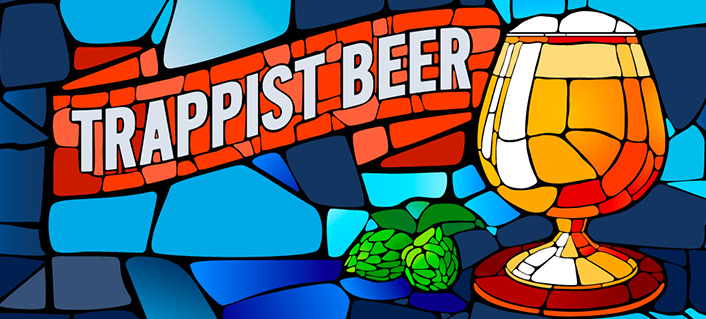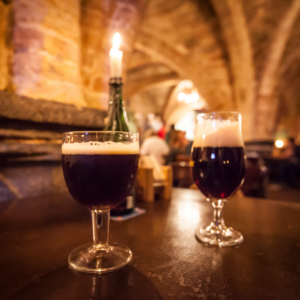Holy Beer! Praise and Glory to the Trappist

Although religious devotion to beer may seem like a modern phenomenon unique to millennials and the craft movement, beer and religion have been connected as long as well…beer and religion. Whether in celebration or condemnation, beer has always played a role in humanity’s spiritual life. In fact, some of the earliest brewers were monks and have been brewing beer since the Middle Ages. Arguably one of the most famous of these orders is the Trappist, whose beer has grown to legendary status. Even if you’ve never tasted a Trappist beer, it’s easy to see why. Robed monks living in an isolated gothic abbey brewing beer through traditional methods. It’s quite romantic, isn’t it? To be fair not every monastery is based in such an idyllic locale, but the concept is still compelling.
So, as we embark on another year, and debates reignite around the relevancy of hard seltzers, now seems like a perfect opportunity to instead reflect on one of the most beloved and timeless beer styles. Join us as we journey to learn what makes a Trappist Ale and hopefully discover why it has remained popular for centuries.

Who are the Trappists?
To fully understand Trappist as a beer style, you must first understand the monks who brew it. Their namesake and origins come from the La Trappe Abbey monastery in France which was originally built as a small chapel in 1120. It would serve as a Cistercian monastery for centuries until 1664 when Armand Jean le Bouthillier de Rancé led a reform and began enacting stricter rules after he felt the order had become too liberal. Thus, the Order of Cistercians of the Strict Observance was born. The monks and nuns in this order would be known as Trappists and Trappistines respectively. Following the Rule of Saint Benedict, the Trappists put great value on the importance of silence and separation from dominant culture, while also balancing the practices of prayer, reading and manual labor. A key tenet of their beliefs is monasteries should be self-supporting and monks should live by the work of their hands. Over the years these monasteries have produced a range of high-quality goods from clothing, furniture to food such as breads, cheeses and of course beer. As of 2021 there are 157 Trappist monasteries worldwide, including 15 in the United States.
Yes, but what about the beer?
Because the Trappists view work as sacred, brewing is treated as a religious act in service of God. This means every aspect of the production from the sourcing of ingredients to the brewing process is approached with the utmost care. Thanks to this attention to detail many Trappist Ales have long been considered the best in the world.
Regarding the beer itself, each monastery produces its own unique style influenced by the regions and traditions they’re located in. But typically, they are thick malty ales, ranging from light to dark in color, full-bodied in flavor, and low in hoppy bitterness. What truly makes a Trappist Ale ‘Trappist’, is actually an official designation attributed by the International Trappist Association (ITA).
For a beer to be labeled an Authentic Trappist Product (ATP) it must meet the following criteria:
- All products must be made within the immediate surroundings of the abbey
- Production must be carried out under the supervision of the monks or nuns
- Profits should be intended for the needs of the monastic community, for purposes of solidarity within the Trappist Order, or for development projects and charitable works.
Given the strict criteria there are only 11 breweries currently producing authentic Trappist beer:
- Bières de Chimay, Belgium
- Stift Engelszell, Austria
- Brouwerij de Koningshoeven (La Trappe), Netherlands
- Mont des Cats, France
- Brasserie d’Orval, Belgium
- Brasserie de Rochefort, Belgium
- Tre Fontane Abbey, Italy
- Mount St Bernard Abbey (Tynt Meadow), England
- Brouwerij der Trappisten van Westmalle, Belgium
- Brouwerij Westvleteren (St Sixtus), Belgium
- Brouwerij Abdij Maria Toevlucht (Zundert), Netherlands
Sadly, the only American Trappist brewery closed in 2022.
In addition to the ATP label, something else you may notice is many Trappist Ales feature a common naming convention. They tend to be labeled either Enkel (single), Dubbel (double), Tripel (triple) or even Quadrupel (Quadruple). As you’ve probably guessed, these note the overall strength of the beer in both flavor and alcohol content. Enkel sometimes called Blonde Ale is the weakest and Quadrupel obviously being the strongest.
A Few Mostly Accessible Classic Examples:
- Chimay Blue
- Orval Trappist Ale
- Rochefort 10
- La Trappe Blond Ale
- Westmalle Tripel
- Westvleteren 12

A note on glassware
Another interesting aspect of Trappist Ales is many of these breweries have their own custom glassware. This usually takes the form of either a goblet or chalice designed to maximize the amount of head in the glass. In fact, many Belgian beers are served in a similar type of glass.
Make your own ‘Trappist’ inspired ale
Unless you’re reading this within the walls of Trappist Monastery it’s safe to say the beer you brew won’t meet the criteria for an official ‘Trappist’ designation. But that doesn’t mean you can’t brew something in honor of this classic style. Thankfully here at BSG we have all the ingredients you need to create your own ‘Trappist’ inspired ale. Just a note of caution, unless you want to be visited by the Trappist’s robed (we’re assuming) legal team don’t put Trappist on the label.
Malt
Given Trappist Ales are low on hoppy bitterness, the malt needs to do all the heavy lifting when it comes to flavor. Most Trappists use a Pils Malt as their base and then combine it with specialty malts to add to the malt and caramel notes. As you move your way up from Single, to Dubbel etc. you’ll want to incorporate a few more specialty malts to turn things up. Keep in mind, however, like the Trappist lifestyle everything should be in balance so no single element should dominate.
Fun fact our friends at Mouterij Dingemans supply malt to all the Trappist breweries in Belgium and Holland. So, you really can’t go wrong with choosing one of their malts. That being said Weyermann and some of our domestic malt options from Gambrinus and Rahr can certainly fit the bill.
Explore more recipes from Dingemans.
Blonde/Single:
Dubbel:
Tripel/Quadrupel:
Sugar
Most Trappist Ales include a bit of additional sugar for added color and increased ABV%.
Candico Belgian Candi Syrup Dark
Hops
As already noted, like most ales Trappists are low on hoppy bitterness. So, you really only want just a hint of hop to help cut some of the sweetness of the malt. Going with a low-alpha noble hop will be your best option to provide the subtle clean flavor you’re looking for.
Hallertau
The quintessential noble hop, mild and approachable with a mixture of sweet, earthy and herbal notes.
Versatile and mild, predominantly spicy with an undercurrent of woods and wild fruit.
American-bred descendent of Hallertau Mittelfrüh, it is moderately intense and sweet with suggestions of herbal notes, flowers and green fruit.
Primarily aroma but can easily be used as a dual-purpose hop. Its mixture of Saaz character with distinct lemon-lime citrus, makes for a unique signature when used throughout the kettle in Belgian ales, or wheat beers.
Yeast
Trappist Ales tend to be top-fermented and go through a second fermentation. They also usually have a higher alcohol content, so you’ll want something with a high attenuation and alcohol tolerance.
The SafAle™ BE-256 we suggest for brewing Trappist style beer as it provides fast fermentation, very high attenuation, high alcohol (v/v) tolerance, and provides subtle aromas with a balanced profile. This also allows a secondary fermentation with another yeast strain, after adding some sugar needed for the carbonation of the final beer
Selected specifically for secondary fermentation in bottles or casks, SafBrew™ BR-8 produces phenolic compounds that create a distinctive finishing touch which evolves over time as the beer is aged.
Additional Reading
Inside Dingemans- An Interview with Karl Dingemans
Sources:
https://www.insightvacations.com/blog/brief-history-trappist-beer/